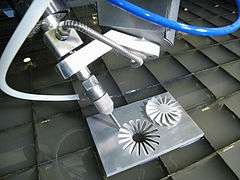Multiaxis machining
Multiaxis machining is a manufacturing process that involves tools that move in 4 or more directions and are used to manufacture parts out of metal or other materials by milling away excess material, by water jet cutting or by laser cutting. This type of machining was originally performed mechanically on large complex machines. These machines operated on 4, 5, 6, and even 12 axes which were controlled individually via levers that rested on cam plates. The cam plates offered the ability to control the tooling device, the table in which the part is secured, as well as rotating the tooling or part within the machine. Due to the machines size and complexity it took extensive amounts of time to set them up for production.[1] Once computer numerically controlled machining was introduced it provided a faster, more efficient method for machining complex parts.

Typical CNC tools support translation in 3 axis; multiaxis machines also support rotation around one or multiple axis. 5-axis machines are commonly used in industry in which the workpiece is translated linearly along three axes (typically x, y, and z) and the tooling spindle is capable of rotation about an addition 2 axes.[2]
There are now many CAM (computer aided manufacturing) software systems available to support multiaxis machining including software that can automatically convert 3-axis toolpaths into 5-axis toolpaths.[3] Prior to the advancement of Computer Aided Manufacturing, transferring information from design to production often required extensive manual labor, generating errors and resulting in wasted time and material.
There are three main components to multiaxis machines:
- The machines physical capabilities i.e. torque, spindle speed, axis orientation/operation.
- The CNC drive system, the components that move the machine. This includes servo-motors, rapid traverse systems, ball screws, and how positioning is monitored.
- The CNC controller, this is how data is transferred/stored within machine, and input data is processed and executed.[4]
Multiaxis machines offer several improvements over other CNC tools, at the cost of increased complexity and price of the machine:
- The amount of human labor is reduced, if the piece would otherwise have to be turned manually during the machining.
- A better surface finish can be obtained by moving the tool tangentially about the surface (as opposed to moving the workpiece around the spindle).
- More complex parts can be manufactured, particularly parts with curved holes.
- Increased tool life due to the ability to achieve optimal angles between the tool and machining surface.
- Higher quality parts. What once required multiple setups now can be executed in only a few if not one, reducing steps and decreasing the opportunity for error.
The number of axes for multiaxis machines varies from 4 to 9.[5] Each axis of movement is implemented either by moving the table (into which the workpiece is attached), or by moving the tool. The actual configuration of axes varies, therefore machines with the same number of axes can differ in the movements that can be performed.
Applications
Common applications for 5-axes machining include complex 3D geometry like turbine blades, cutting tools, and parts that require interior cuts that would be otherwise inaccessible with a simple 3-axis setup. Given that the two additional axes allow for angling of the spindle head relative to the machining surface it is also often used to machine sloped surfaces into part features.[2]
See also
- Machine tool
- Milling machine
- Numerical control
- CNC pocket milling
References
- Apro, Karlo (2009). Secrets of 5-axis machining. Industrial Press. ISBN 9780831133757. OCLC 1008856747.
- "What Are The Main Applications For 5-Axis CNC Machining? - Kentin Engineering Australia". Kentin Engineering Australia. 2016-05-05. Retrieved 2018-11-17.
- MCADCafé. Sescoi's WorkNC 5-Axis and Auto 5 - a competitive advantage at ALLIO.
- https://search.proquest.com/docview/1269154092
- Karlo Apro (2008). Secrets of 5-Axis Machining. Industrial Press Inc. ISBN 0-8311-3375-9.